 |
 |
Our enthusiastic and extremely knowledgeable perennials team is here to answer your questions and help you choose the best perennials for your situation. There’s always something in bloom for sun, shade, butterflies, birds or deer resistance as well as a variety of bulbs for your space.
Stroll through our time-tested favorites and introduce yourself to the newest varieties. We garden with perennials too; we love them and it shows!
|
19 found, showing page 1 of 2
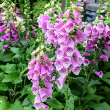
Plant Height: 3 feet
Flower Height: 4 feet
Spacing: 14 inches
Sunlight: full sun, partial shade
Hardiness Zone: 4a
Group/Class: Dalmatian Series Description:
Exciting rose-purple tubular flowers with white interiors and dark purple spots; tall spikes rise above attractive green lance-shaped leaves; a biennial that's happiest in part shade with adequate moisture
Ornamental Features:
Dalmatian Rose Foxglove features bold spikes of rose tubular flowers with violet overtones and deep purple spots rising above the foliage from late spring to mid summer. The flowers are excellent for cutting. Its pointy leaves remain green in color throughout the season.
Landscape Attributes:
Dalmatian Rose Foxglove is an herbaceous perennial with a rigidly upright and towering form. Its medium texture blends into the garden, but can always be balanced by a couple of finer or coarser plants for an effective composition.
This plant will require occasional maintenance and upkeep, and is best cleaned up in early spring before it resumes active growth for the season. It is a good choice for attracting hummingbirds to your yard, but is not particularly attractive to deer who tend to leave it alone in favor of tastier treats. Gardeners should be aware of the following characteristic(s) that may warrant special consideration:
-Self-Seeding
Dalmatian Rose Foxglove is recommended for the following landscape applications:
- Vertical Accent
- Mass Planting
- General Garden Use
- Container Planting
- Planting & Growing
Dalmatian Rose Foxglove will grow to be about 3 feet tall at maturity extending to 4 feet tall with the flowers, with a spread of 18 inches. When grown in masses or used as a bedding plant, individual plants should be spaced approximately 14 inches apart. It tends to be leggy, with a typical clearance of 1 foot from the ground, and should be underplanted with lower-growing perennials. It grows at a fast rate, and tends to be biennial, meaning that it puts on vegetative growth the first year, flowers the second, and then dies. However, this species tends to self-seed and will thereby endure for years in the garden if allowed. As an herbaceous perennial, this plant will usually die back to the crown each winter, and will regrow from the base each spring. Be careful not to disturb the crown in late winter when it may not be readily seen!
This plant does best in full sun to partial shade. It does best in average to evenly moist conditions, but will not tolerate standing water. It is not particular as to soil type or pH. It is highly tolerant of urban pollution and will even thrive in inner city environments. This is a selected variety of a species not originally from North America, and parts of it are known to be toxic to humans and animals, so care should be exercised in planting it around children and pets.
Dalmatian Rose Foxglove is a fine choice for the garden, but it is also a good selection for planting in outdoor pots and containers. With its upright habit of growth, it is best suited for use as a 'thriller' in the 'spiller-thriller-filler' container combination; plant it near the center of the pot, surrounded by smaller plants and those that spill over the edges. It is even sizeable enough that it can be grown alone in a suitable container. Note that when growing plants in outdoor containers and baskets, they may require more frequent waterings than they would in the yard or garden.
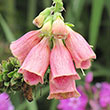
Deep pink blooms on spires. Perennial hybrid. Toxic. USDA 4-8
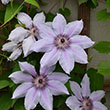
Showy pale pink flowes with carmine midstripe. Blooms on old and new growth. USDA 4-8

Profuse ruffled pale pink 5-6" flowers with a wide, deep reddish pink central bar. Thrives in full sun, tolerates shade. Blooms in spring and summer. USDA 4-11

Pink blooms. Self-seeding groundcover. Tolerates clay. USDA 3-8

Ruffled petals with sunset pink and coral tones. Black walnut tolerant. USDA 3-9
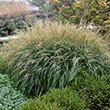
'Adagio' Maiden Grass | Pinkish blooms. Upright clumping grass. Self-seeding. USDA 5-9
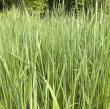
Height: 5 feet
Spread: 32 inches
Sunlight: full sun, partial shade
Hardiness Zone: 3a
Other Names: Feather Reed Grass
Description:
Dramatic red-copper plumes are eye catching during the early to mid summer months; a cool weather performer that looks wonderful in fresh or dried flower arrangements, borders or garden landscapes; heat tolerant and low maintenance
Ornamental Features:
Karl Foerster Reed Grass is primarily grown for its highly ornamental fruit. The tan seed heads are carried on showy plumes displayed in abundance from late summer to late winter. It features bold plumes of brick red flowers with coppery-bronze overtones rising above the foliage in mid summer. Its grassy leaves are green in color. The foliage often turns tan in fall. The gold stems can be quite attractive.
Landscape Attributes:
Karl Foerster Reed Grass is an herbaceous perennial grass with an upright spreading habit of growth. It brings an extremely fine and delicate texture to the garden composition and should be used to full effect.
This plant will require occasional maintenance and upkeep, and is best cut back to the ground in late winter before active growth resumes. It has no significant negative characteristics.
Karl Foerster Reed Grass is recommended for the following landscape applications:
- Vertical Accent
- Mass Planting
- General Garden Use
- Groundcover
- Naturalizing And Woodland Gardens
- Container Planting
Planting & Growing:
Karl Foerster Reed Grass will grow to be about 4 feet tall at maturity, with a spread of 32 inches. It tends to be leggy, with a typical clearance of 1 foot from the ground, and should be underplanted with lower-growing perennials. It grows at a medium rate, and under ideal conditions can be expected to live for approximately 10 years. As an herbaceous perennial, this plant will usually die back to the crown each winter, and will regrow from the base each spring. Be careful not to disturb the crown in late winter when it may not be readily seen!
This plant does best in full sun to partial shade. It is very adaptable to both dry and moist locations, and should do just fine under typical garden conditions. It is not particular as to soil type or pH. It is highly tolerant of urban pollution and will even thrive in inner city environments. This particular variety is an interspecific hybrid. It can be propagated by division; however, as a cultivated variety, be aware that it may be subject to certain restrictions or prohibitions on propagation.
Karl Foerster Reed Grass is a fine choice for the garden, but it is also a good selection for planting in outdoor pots and containers. With its upright habit of growth, it is best suited for use as a 'thriller' in the 'spiller-thriller-filler' container combination; plant it near the center of the pot, surrounded by smaller plants and those that spill over the edges. It is even sizeable enough that it can be grown alone in a suitable container. Note that when growing plants in outdoor containers and baskets, they may require more frequent waterings than they would in the yard or garden.
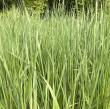
Upright. Pink-purple feathery summer blooms. Prefers moist soils. Tolerates clay and sandy soils. USDA 5-9
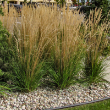
Height: 5 feet
Spread: 32 inches
Sunlight: full sun, partial shade
Hardiness Zone: 3a
Other Names: Feather Reed Grass
Description:
Dramatic red-copper plumes are eye catching during the early to mid summer months; a cool weather performer that looks wonderful in fresh or dried flower arrangements, borders or garden landscapes; heat tolerant and low maintenance
Ornamental Features:
Karl Foerster Reed Grass is primarily grown for its highly ornamental fruit. The tan seed heads are carried on showy plumes displayed in abundance from late summer to late winter. It features bold plumes of brick red flowers with coppery-bronze overtones rising above the foliage in mid summer. Its grassy leaves are green in color. The foliage often turns tan in fall. The gold stems can be quite attractive.
Landscape Attributes:
Karl Foerster Reed Grass is an herbaceous perennial grass with an upright spreading habit of growth. It brings an extremely fine and delicate texture to the garden composition and should be used to full effect.
This plant will require occasional maintenance and upkeep, and is best cut back to the ground in late winter before active growth resumes. It has no significant negative characteristics.
Karl Foerster Reed Grass is recommended for the following landscape applications:
- Vertical Accent
- Mass Planting
- General Garden Use
- Groundcover
- Naturalizing And Woodland Gardens
- Container Planting
- Planting & Growing
Karl Foerster Reed Grass will grow to be about 4 feet tall at maturity, with a spread of 32 inches. It tends to be leggy, with a typical clearance of 1 foot from the ground, and should be underplanted with lower-growing perennials. It grows at a medium rate, and under ideal conditions can be expected to live for approximately 10 years. As an herbaceous perennial, this plant will usually die back to the crown each winter, and will regrow from the base each spring. Be careful not to disturb the crown in late winter when it may not be readily seen!
This plant does best in full sun to partial shade. It is very adaptable to both dry and moist locations, and should do just fine under typical garden conditions. It is not particular as to soil type or pH. It is highly tolerant of urban pollution and will even thrive in inner city environments. This particular variety is an interspecific hybrid. It can be propagated by division; however, as a cultivated variety, be aware that it may be subject to certain restrictions or prohibitions on propagation.
Karl Foerster Reed Grass is a fine choice for the garden, but it is also a good selection for planting in outdoor pots and containers. With its upright habit of growth, it is best suited for use as a 'thriller' in the 'spiller-thriller-filler' container combination; plant it near the center of the pot, surrounded by smaller plants and those that spill over the edges. It is even sizeable enough that it can be grown alone in a suitable container. Note that when growing plants in outdoor containers and baskets, they may require more frequent waterings than they would in the yard or garden.
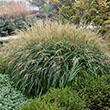
Pinkish blooms. Upright clumping grass. Self-seeding. USDA 5-9
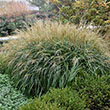
Pinkish blooms. Upright clumping grass. Self-seeding. USDA 5-9
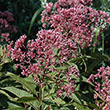
Pink blooms. Tolerates clay & wet soils. Native cultivar. Naturalizing. USDA 4-8
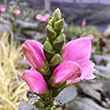
Uniquely shaped, hot pink blooms atop dark green leaves with a bronzy sheen.Best of moist or wet shade. Showy and long lived. USDA 4-9
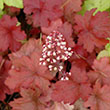
Plant Height: 9 inches
Flower Height: 14 inches
Spacing: 12 inches
Sunlight: full sun, partial shade, full shade
Hardiness Zone: 4a
Other Names: Coralbells, Alumroot
Description:
The reddest foliage in spring turns radiant copper-orange with red veins, returning to red in fall; pink bells in early summer; amazing color addition with great versatility; keep soil moist in heat of summer
Ornamental Features:
Fire Alarm Coral Bells features dainty spikes of pink bell-shaped flowers rising above the foliage in early summer. Its attractive tomentose lobed leaves emerge crimson in spring, turning orange in color with distinctive dark red veins. The foliage often turns crimson in fall.
Landscape Attributes:
Fire Alarm Coral Bells is a dense herbaceous evergreen perennial with tall flower stalks held atop a low mound of foliage. Its relatively fine texture sets it apart from other garden plants with less refined foliage.
This is a relatively low maintenance plant, and should be cut back in late fall in preparation for winter. It is a good choice for attracting hummingbirds to your yard. It has no significant negative characteristics.
Fire Alarm Coral Bells is recommended for the following landscape applications:
- Mass Planting
- Rock/Alpine Gardens
- Border Edging
- General Garden Use
- Groundcover
- Container Planting
- Planting & Growing
Fire Alarm Coral Bells will grow to be about 9 inches tall at maturity extending to 14 inches tall with the flowers, with a spread of 14 inches. When grown in masses or used as a bedding plant, individual plants should be spaced approximately 12 inches apart. Its foliage tends to remain low and dense right to the ground. It grows at a medium rate, and under ideal conditions can be expected to live for approximately 10 years. As an evegreen perennial, this plant will typically keep its form and foliage year-round.
This plant performs well in both full sun and full shade. However, you may want to keep it away from hot, dry locations that receive direct afternoon sun or which get reflected sunlight, such as against the south side of a white wall. It prefers to grow in average to moist conditions, and shouldn't be allowed to dry out. It is not particular as to soil type or pH. It is somewhat tolerant of urban pollution. Consider covering it with a thick layer of mulch in winter to protect it in exposed locations or colder microclimates. This particular variety is an interspecific hybrid. It can be propagated by division; however, as a cultivated variety, be aware that it may be subject to certain restrictions or prohibitions on propagation.
Fire Alarm Coral Bells is a fine choice for the garden, but it is also a good selection for planting in outdoor pots and containers. It is often used as a 'filler' in the 'spiller-thriller-filler' container combination, providing a mass of flowers and foliage against which the larger thriller plants stand out. Note that when growing plants in outdoor containers and baskets, they may require more frequent waterings than they would in the yard or garden.
19 found, showing page 1 of 2













